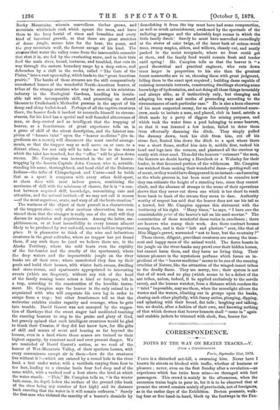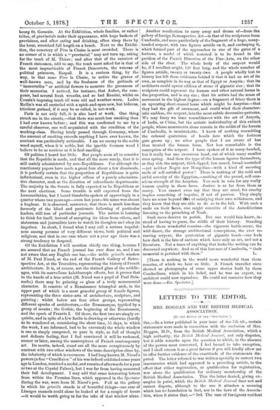CORRESPONDENCE.
NOTES BY THE WAY ON BEATEN TRACKS.—V.
[FROM A CORRESPOIMENT.
Paris, September 21st, 1878. PARIS is a disturbed ant-bill, a swarming hive. Never have I known its streets so blocked with traffic, whether of business or pleasure ; never, even on the first Sunday after a revolution—an experience which has twice been mine—so thronged with foot passengers. This crowd is mainly in the afternoons, when the excursion trains begin to pour in, for it is to be observed that at present the crowd consists mainly of provincials, not of foreigners, as in the earlier days of the Exhibition. Breton peasants, walk- ing four or five hand-in-hand, block up the footways in the Fan-
bourg St. Germain. At the Exhibition, whole families, or rather tribes, of provincials make their appearance, with huge baskets of provisions, and after eating and drinking, often sleep there by the hour, stretched full length on a bench. Next to the Exhibi- tion, the cemetery of Pere la Chaise is most crowded. There is no corner of it in which a " provincial " may not turn up, asking for the tomb of M. Thiers ; and after that of the canniest of French statesmen, odd to say, the tomb most asked for is that of the most impracticable of French Democrats, the veteran of political prisoners, Raspail. It is a curious thing, by the way, in that same Pere la Chaise, to notice the graves of well-known men, and by the freshness of the garlands of "immortelles " or artificial flowers to measure the greenness of their memories. I noticed, for instance, that Anber, the com- poser, had several fresh wreaths, and so bad Rossini, whilst on Cousin's imposing tomb all were old and weather-worn. Ledru Rollin's was all encircled with a spick-and-span new, but hideous, tricolour garland, if it may be so called, in net-work.
Paris is not only full, it is also hard at work. One thing struck me in the streets,—that there was much less smoking than I had ever known before ; and this was confirmed to me by a careful observer, one well acquainted with the condition of the working-class. Having lately passed through Germany, where the amount of smoking exceeds anything I have ever known, the contrast was particularly noticeable. I am no enemy to the noble weed myself, when it is noble, but the ignoble German weed I believe to be as noxious as it is foul-smelling.
Of politics I heard but little. But people seem all to consider that the Republic is made, and that all the more surely, that it is still mainly administered by non-Republicans. For although the reactionary papers have made a great fuss about a few dismissals, it is perfectly certain that the proportion of Republicans is quite infinitesimal, even in the higher offices of a purely administra- tive character, such as the direction of subordinate departments. The majority in the Senate is fully expected to be Republican at the next elections. Some trouble is still expected from the Irreconcilables, but I heard Gambetta spoken of approvingly in a quarter where two years ago—even last year—his name was almost a bugbear. It is observed, moreover, that there is much less than formerly of the blind and passionate following of particular leaders, still less of particular journals. The nation is learning to think for itself, instead of accepting its ideas from others, and statesmen and journalists have to watch its thoughts and obey its impulses. In short, I found what I may call a serious hopeful- ness among persons of very different views, both political and religious, and that in one case where not a year ago there was a strong tendency to despond.
Of the Exhibition I will mention chiefly one thing, because I am assured that no French journal has ever done so, and I am not aware that any English one has,—the noble grisaille window of M. Paul Nicod, at the end of the French Gallery of Retro- spective Art, at the Trocadero, representing the history of French architecture. It is, of course, not the stained glass of the middle- ages, with its marvellous kaleidoscopic effects, but it proves that in the hands of a true artist (M. Nicod was a pupil of Paul Dela- roche) there may be painting on glass of a truly monumental character. It consists of a Renaissance triumphal arch, in the upper part of which is a most graceful group of female figures, representing the three sister-arts of architecture, sculpture, and painting ; whilst below are four other groups, representing different epochs of architecture,—the Romanesque, typified by a group of monks ; the Gothic, the beginning of the Renaissance, and the epoch of Francis.L Of these, the first two are simply ex- quisite, and in spite of a few faults in drawing or otherwise (hardly to be wondered at, considering the short time, 55 days, in which the work, I am informed, had to be executed) the whole window is one so simply composed, so pure in style, so full of thought and delicate feeling, that I feel convinced it will be reckoned, sooner or later, among the masterpieces of French contemporary art. Its merits, indeed, stand out all the more conspicuously by contrast with two other windows of the same description close by, the inferiority of which is enormous. I had long known M. Nicod's powers (a fine " Crucifixion " of his was indeed exhibited some years ago in London, received a medal, and remained afterwards for a year or two at the Crystal Palace), but I was far from having measured their full development. I may add that some interesting letters from within the Prussian lines, which appeared in the Spectator during the war, were from M. Nicod's pen. Full as the gallery in which his grisaille stands is of beautiful things—one case of Limoges enamels could alone be looked at for a couple of hours —it would be worth going to for the sake of that window alone.
Another recollection to carry away and dream of—from the gallery of foreign Retrospective Art—is that of the sculptures from Cambodia, and more particularly of the fragment of a huge, many- headed serpent, with two figures astride on it, and enclasping it, which formed part of the approaches to one of the gates of a fortress, a model of which restored is to be found in the pavilion of the French Direction of the Fine-Arts, on the other side of the river. The whole body of the serpent would be, if I recollect aright, 120 feet long, and the whole number of figures astride, twenty or twenty-two. A people wholly lost to history has left these evidences behind it that it had an art of its own, as complete in its way as that of Egypt or Assyria ; that its architects could uprear edifices of stone of gigantic size ; that its sculptors could represent the human and other natural forms in due proportion, and in any size ; that its artists had the sense of movement in the highest degree—on a fragment of frieze there is an uprearing short-maned horse which might be Assyrian—that they had the gift of ornament, and could wind their character- istic emblem, the serpent, into the most subtle decorative patterns.
We may fancy we trace resemblances with the art of Assyria, of India, or China, but the artistic individuality of this extinct people, whose monuments alone remain in the midst of the forests of Cambodia, is unmistakable. I know of nothing resembling the colossal quaternion of heads into which the fortress gate grows up ; no other people that I am aware of has thus treated the human form. Not less remarkable is the conception of the serpent. I have spoken of it as many-headed, but it really has one enormous head, out of which many smaller ones spring. And then the type of the human figures themselves, as they ride the serpent, thick-lipped, low-nosed, broad-nostriled —yet neither Negro nor Mongolian—with a kind of sneering smile of self-satisfied power ! There is nothing of the cold and awful serenity of the Egyptian,—nothing of the proud, self-con- scious strength of the Assyrian. You seek in vain for any really human quality in these faces. Justice is as far from them as mercy. You cannot even say that they are cruel, for cruelty implies something of impulse, if not of passion. They simply have no sense beyond tat of satisfying their own selfishness, and they know that they are able to do so to the full. With such a smile on their faces, one might conceive of the Antediluvians listening to the preaching of Noah.
Such races deserve to perish. But one would fain know, in- stead of having to guess, the riddle of their history. Standing before these wonderful remains—the vigorous battle-scene, the wild dance, the strange architectural conceptions, the ever re- curring serpent, the quaternion of gigantic heads—one feels how dark is the fate of nations which have only an art, and not a literature. Not a trace of anything that looks like writing can be discerned anywhere. And so of this lost race of Cambodia, " their memorial is perished with them." L.
[There is nothing in the world more wonderful than these remains, of which we hear so little. A French traveller once showed us photographs of some upper stories built by these Cambodians, which in his belief, and he was an expert, no architect could now reproduce. He could not conceive how they were done.—En. Spectator.]



































 Previous page
Previous page